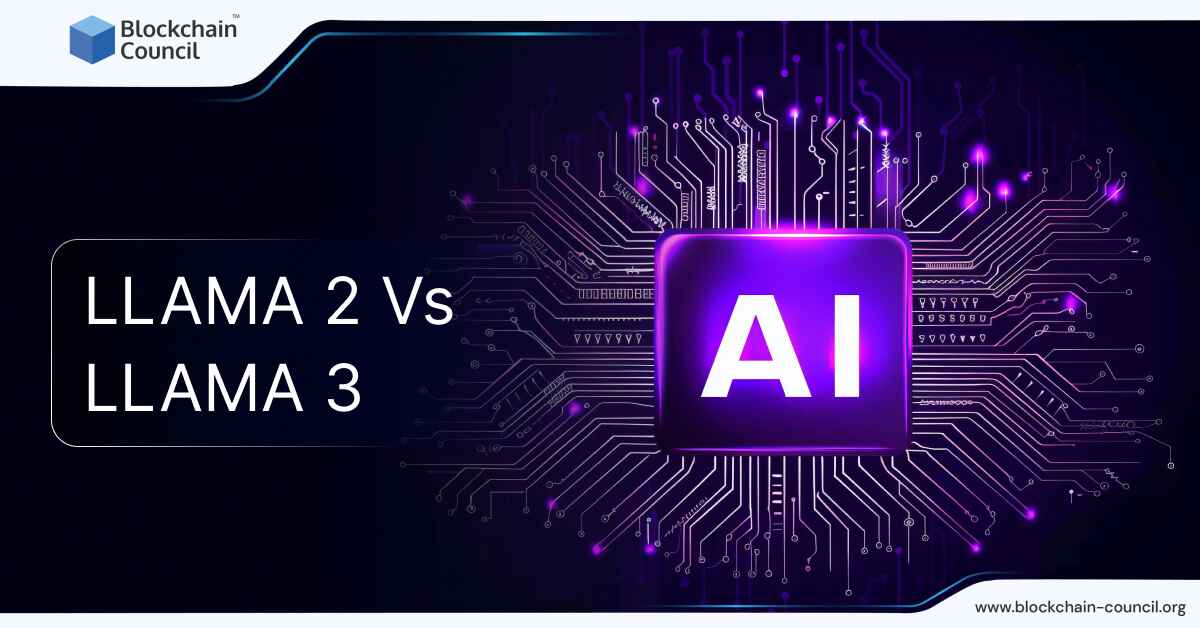
- Blockchain Council
- August 22, 2024
The landscape of large language models (LLMs) is constantly evolving, with each new iteration pushing the boundaries of what these powerful tools can achieve. Meta’s LLAMA series has been a significant player in this field, with LLAMA 2 making waves in 2023 and LLAMA 3 following up with substantial improvements in 2024.
Introduction to LLAMA 2 and LLAMA 3
Meta introduced LLAMA 2 in July 2023 as a successor to its earlier models, designed to offer improved language understanding, better handling of complex tasks, and enhanced open-source accessibility. LLAMA 3, released in April 2024, builds on the foundations of LLAMA 2, incorporating advanced techniques and a significantly larger training dataset to achieve superior performance.
LLAMA 2 Vs LLAMA 3: Architecture and Training Enhancements
One of the most critical upgrades from LLAMA 2 to LLAMA 3 is the architecture. LLAMA 3 includes several optimizations that make it more efficient and capable than its predecessor.
- Tokenization and Vocabulary: LLAMA 3 employs a more efficient tokenizer with a vocabulary of 128,000 tokens, a significant increase from LLAMA 2. This allows the model to encode language more effectively, leading to better performance across a wide range of tasks.
- Model Architecture: LLAMA 3 incorporates enhancements like Grouped Query Attention (GQA) to improve inference efficiency. These architectural improvements help LLAMA 3 manage complex language tasks with greater accuracy and speed.
- Training Data: The training data for LLAMA 3 is over seven times larger than that used for LLAMA 2, with more than 15 trillion tokens. This includes a broader range of data sources, including a significant increase in non-English text and code data. This extensive dataset helps LLAMA 3 perform well in multilingual tasks and code generation, areas where LLAMA 2 had limitations.
LLAMA 2 Vs LLAMA 3: Performance Improvements
LLAMA 3’s enhancements in architecture and training directly translate to better performance in several key areas:
- Context Window: LLAMA 3 doubles the context window size from 4,000 tokens in LLAMA 2 to 8,000 tokens. This expansion allows the model to consider more information when generating responses, leading to more coherent and contextually appropriate outputs.
- Reasoning and Code Generation: LLAMA 3 shows marked improvements in reasoning and code generation tasks, outstripping LLAMA 2 in benchmarks like ARC (Abstract Reasoning Corpus) and DROP (Dynamic Reasoning Over Paragraphs). The model’s ability to follow instructions and complete complex, multi-step tasks has also been significantly enhanced.
- Response Diversity and Accuracy: LLAMA 3 is designed to produce more diverse and accurate responses, thanks to its refined post-training techniques such as supervised fine-tuning and rejection sampling. These methods reduce the model’s false rejection rates and improve its alignment with user instructions.
Usability and Accessibility
Meta has made significant strides in making LLAMA 3 more accessible across various platforms and use cases:
- Deployment and Platform Support: LLAMA 3 is designed to be highly accessible, with support for multiple platforms including AWS, Google Cloud, and Microsoft Azure. It also supports various hardware platforms, making it easier for developers to deploy and use the model in different environments.
- Model Sizes and Flexibility: LLAMA 3 is available in two main sizes, 8 billion and 70 billion parameters, allowing users to choose a model that best fits their computational resources and application needs. LLAMA 3.1, released in July 2024, further expanded this with a colossal 405 billion parameter model, indicating Meta’s commitment to scaling up these models for more demanding applications.
- Safety and Responsibility: LLAMA 3 places a strong emphasis on safety, introducing tools like LLAMA Guard 2 and Code Shield to filter insecure code and assess cybersecurity risks. These tools make LLAMA 3 a safer choice for deployment in environments where security is a concern.
Practical Applications
LLAMA 3’s advanced capabilities open up a wide range of applications that go beyond what was possible with LLAMA 2:
- Integration with Meta’s Platforms: LLAMA 3 has been integrated into Meta’s core products, such as Facebook Messenger, Instagram, and WhatsApp, where it functions as an AI assistant. This integration allows users to leverage LLAMA 3 for tasks like summarizing research papers or generating creative writing prompts directly within these platforms.
- Multilingual and Multimodal Capabilities: LLAMA 3 is designed with a strong focus on multilingualism, making it more effective in non-English language tasks. Future iterations are expected to further enhance its multimodal capabilities, integrating text with other forms of data like images and videos.
Conclusion
LLAMA 3 represents a significant leap forward in the development of large language models. With its enhanced architecture, expanded training data, and improved usability, it offers a more powerful and flexible tool for a wide range of applications. While LLAMA 2 set a strong foundation, LLAMA 3 builds on this to deliver a model that is more capable, accessible, and safe for users across different domains. To make the most of such language models, make sure to enroll into globally recognized certifications like the Certified Prompt Engineer™ by the Blockhcian Council. These certifications will help you make the most of these models and land your dream job in the AI field.
FAQs
What are the main differences between LLAMA 2 and LLAMA 3?
- Training Data: LLAMA 3 uses over 15 trillion tokens, which is more than seven times the amount used in LLAMA 2.
- Context Window: LLAMA 3 has an expanded context window of 8,000 tokens, double that of LLAMA 2.
- Performance: LLAMA 3 shows improved reasoning, code generation, and response diversity compared to LLAMA 2.
- Architecture: LLAMA 3 includes advanced features like Grouped Query Attention (GQA) and a more efficient tokenizer with 128,000 tokens.
How does LLAMA 3 perform better in tasks than LLAMA 2?
- Reasoning and Logic: LLAMA 3 handles complex reasoning tasks more effectively.
- Instruction Following: Enhanced post-training techniques allow LLAMA 3 to follow instructions with greater precision.
- Code Generation: LLAMA 3 has improved capabilities in generating and understanding code.
- Response Accuracy: The model offers more diverse and contextually appropriate responses.
Where can I access LLAMA 3 models?
- LLAMA 3 is available on AWS, Google Cloud, and Microsoft Azure.
- It supports various hardware platforms, including AMD, NVIDIA, and Intel.
- Available in 8B and 70B parameters, with a 405B version introduced in LLAMA 3.1.
What are the safety features of LLAMA 3?
- LLAMA Guard 2: Helps filter out insecure code.
- Code Shield: Assesses cybersecurity risks in code generation.
- Proximal Policy Optimization (PPO): Enhances model performance while ensuring safer outputs.
- Accessibility: Designed for safe deployment across multiple environments.





































































 Guides
Guides News
News Blockchain
Blockchain Cryptocurrency
& Digital Assets
Cryptocurrency
& Digital Assets Web3
Web3 Metaverse & NFTs
Metaverse & NFTs
